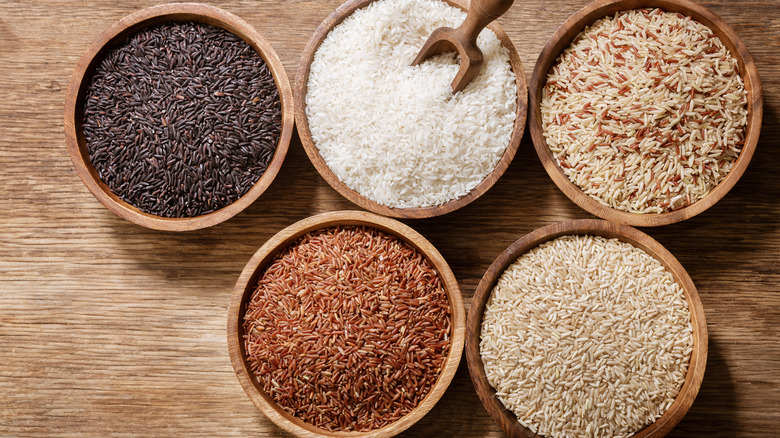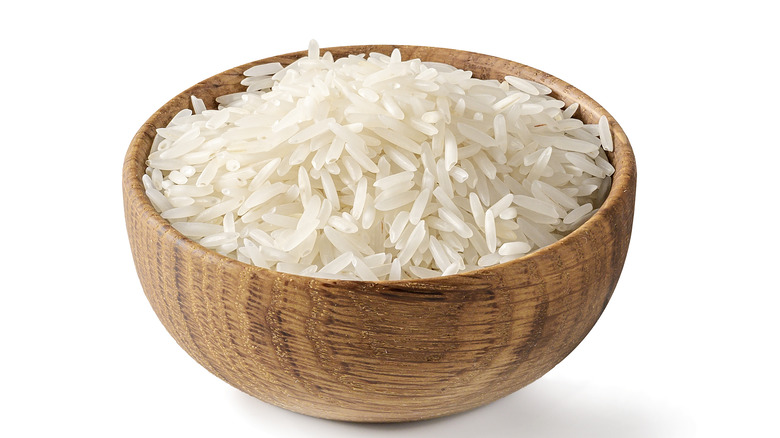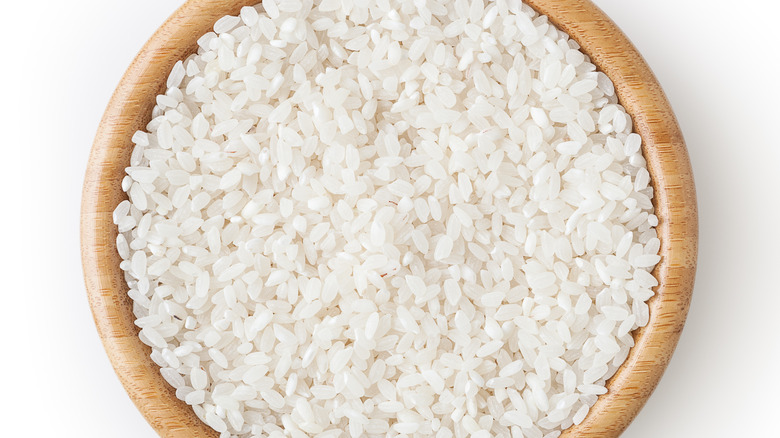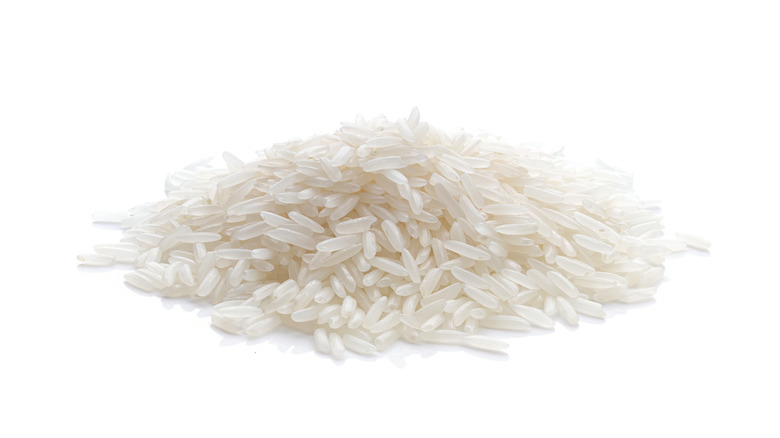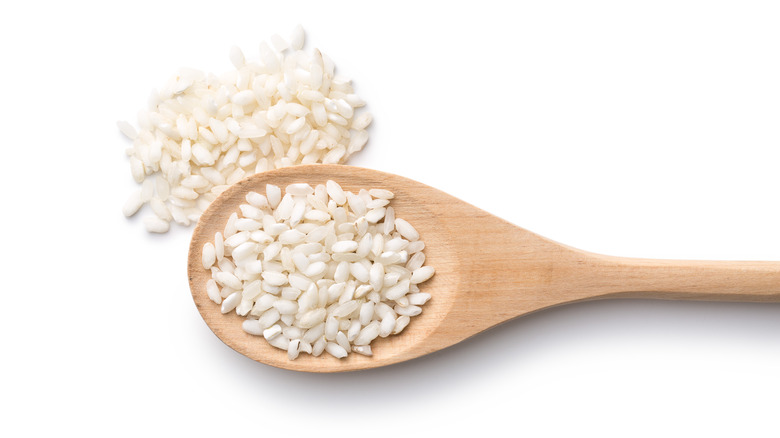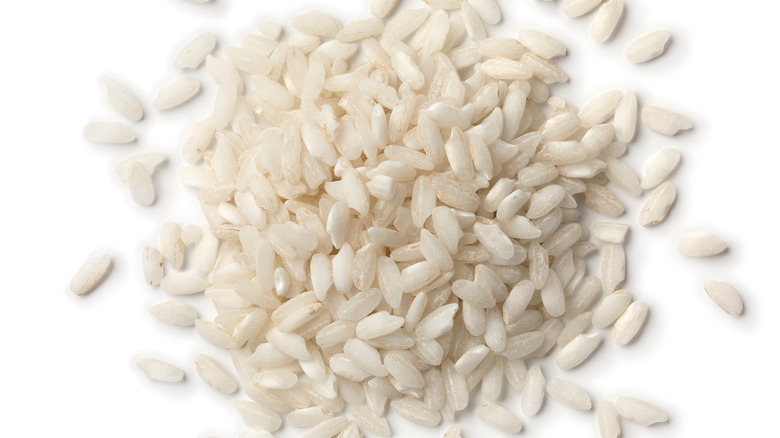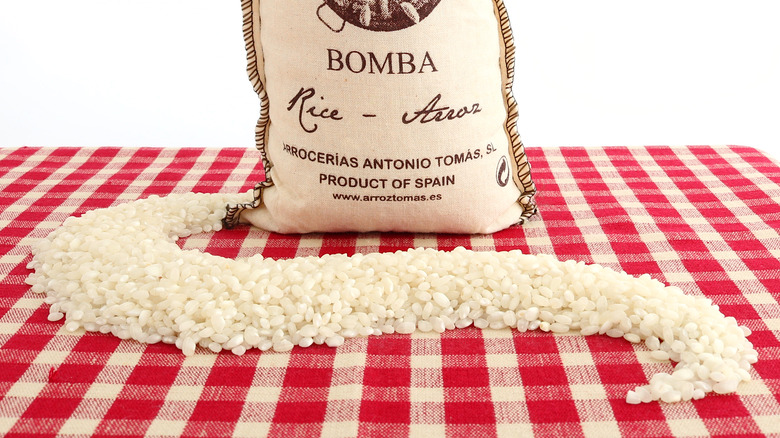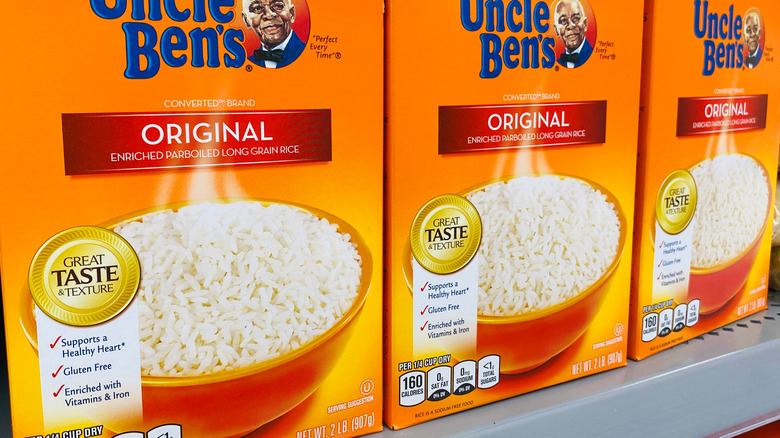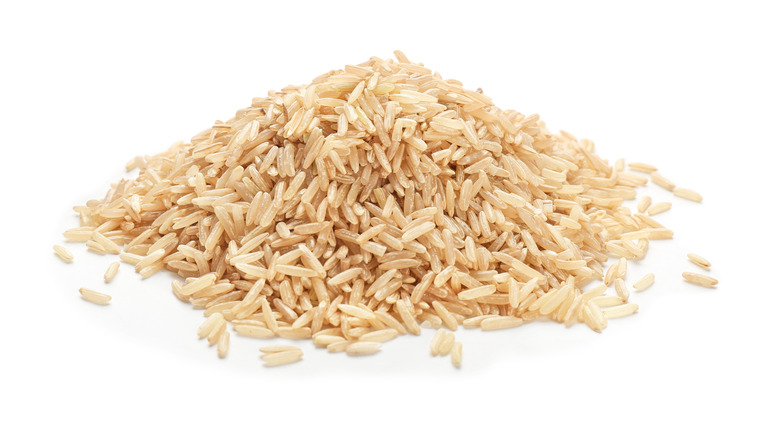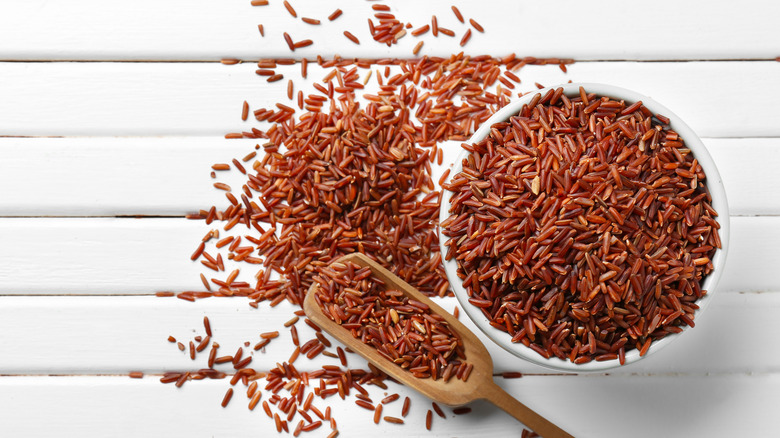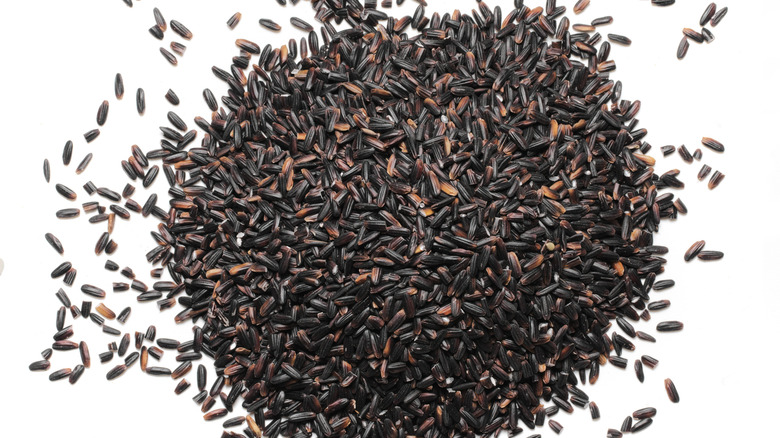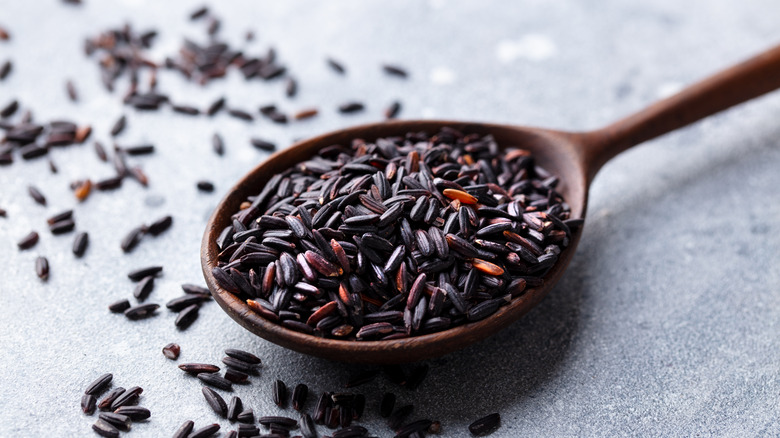Every Type Of Rice And What It's Best Used For
We may receive a commission on purchases made from links.
Rice originally hails from China, where it was first domesticated over 9,000 years ago, but today, it's enjoyed the world over. Rice is often categorized in terms of its color: White rice is rice that has had its dark outer husk removed, revealing the tender grain within, while the brown, red, and black varieties retain this husk (via Rice Knowledge Bank). The bran imparts a nuttier flavor, not to mention more fiber, but it also means that the rice takes longer to cook. Red and black rice may also be richer in some nutrients than white or brown rice (via Thrive Cuisine).
Rice is also sold in a variety of lengths, from short to medium to long (via Tasting Table). Long-grain rice tends to cook up fluffier, while medium- and short-grain are more likely to be stickier. This is due not just to the length of the grain, but also to whether it contains more amylose or amylopectin. The ratio of these two starches varies from rice to rice, with long-grain rice tending to have the most amylose and the least amylopectin, and short-grain rice having the opposite ratio (via Rouxbe). Since the latter is what contributes to the stickiness of a given rice, short-grain rice tend to cook up stickier, while medium-grain rice, which has a balance of both, tend to allow for creamier preparations.
So which type of rice is the best choice to use for your particular cooking needs? Let's dig a little deeper.
Basmati rice
Basmati rice is a long-grain rice hailing from the Northern India and Pakistan. According to Once Upon a Chef, its name comes from the Hindi for "full of aroma" — and one sniff of this aromatic rice will tell you why! It's best paired with foods from Southeast Asia, like chicken tikka masala or sweet potato curry.
Basmati rice can be sold in white or brown forms. White basmati has a lower glycemic index than many other white rices and boasts fiber and B vitamins like folate (via WebMD). The brown variety, while slightly higher in calories, boasts about 20% more fiber than other forms of brown rice. Basmati rice is relatively easy to find in most supermarkets, but if you can't locate it, try an Indian grocer.
It is often advised to rinse the excess starch from basmati rice before cooking it. Jenn Segal from Once Upon a Chef recommends rinsing your basmati and then combining the rice with water, butter, and salt before cooking it at a simmer for 15 to 20 minutes.
Others, like Nagi of RecipeTinEats, eschew rinsing and instead recommend cooking basmati rice using the absorption method. The rice is combined with one and a half times its volume in water and brought to a simmer in an uncovered saucepan. Then you just reduce the heat to medium-low, cover, and cook for 12 minutes. After resting 10 minutes off the heat, the rice should be fluffy and the grains perfectly separated.
Sushi rice
Sushi rice is a short-grain rice originally hailing from East Asia. Given its name, it's perhaps no surprise that it's best suited to sushi, thanks to its high amylopectin content, which contributes to its naturally sticky nature.
Cooking sushi rice perfectly is an art form that sushi chefs spend a great deal of time mastering. When prepared for sushi, sushi rice is usually first rinsed and soaked to remove any excess starch. It is then steamed — either on the stovetop or in a rice cooker — and then seasoned with vinegar, sugar, and salt. These seasonings are incorporated into the rice using a special paddle, and the cook should simultaneously fan the rice to cool it down, ensuring a shiny appearance and the perfect texture.
You can find sushi rice in many supermarkets, but if yours doesn't sell it, it's very easy to find in Asian grocers or online. Sushi rice is available in both white and brown forms, though the white form is more traditional in Japan. According to Very Well Fit, it has a higher glycemic index than long-grain rice, with brown sushi rice boasting more fiber than white (via Live Strong). When prepared for sushi, sushi rice also contains some added calories due to the addition of sugar.
Jasmine rice
Jasmine rice is a long-grain rice hailing from Southeast Asia. Known for its subtle, pleasant aroma, it's best served with Lao, Cambodian, or Thai dishes like Thai red curry or Thai green curry. In fact, jasmine rice is also sometimes marketed as Thai rice! It's a popular long-grain rice option on most supermarket shelves, but if you can't find it, your local Asian supermarket will likely stock it.
Unlike fellow fragrant long-grain rice, white jasmine rice actually has a relatively high glycemic index as compared to many other rices (via Upgrade My Food). Jasmine rice also comes in brown as well as black, purple, and red varieties. Per Healthline, these hull-on varieties will have more fiber, while the red, purple, and black iterations will also boast more antioxidants.
Jasmine rice is best cooked by absorption, albeit with a bit less water than basmati. According to RecipeTinEats, jasmine rice is actually softer than many other rice varieties, meaning it requires less water: about 1 ¼ times its volume, as compared to the 1 ½ times needed to cook basmati rice.
Arborio rice
If you're a risotto fan, you've likely already encountered arborio rice. This starchy rice is categorized as short-grain by some or medium-grain by others. Indeed, it's one of the largest among the short-grain Italian rices, thus the discrepancy!
This rice, unsurprisingly, hails from Italy, and more specifically from the commune of Arborio in Piedmont (via Taste Atlas). It can certainly be rinsed and cooked via the absorption method, like other rices, but it's best when cooked as a risotto in recipes like parmesan risotto or chicken risotto, or even in sweet recipes like rice pudding, which shows off the creamy miracle that is its subtle, natural balance between amylose and amylopectin. In fact, one cup of arborio rice can absorb up to four cups of liquid and still retain a delightful toothsomeness.
Arborio is perhaps the easiest risotto rice to find in supermarkets. Higher in fiber than regular white rice, it's also pretty high in carbs (via The Forked Spoon), and while more nutrient-dense brown versions do exist, they're harder to find and not nearly as prized as white arborio for risotto.
Carnaroli rice
Carnaroli rice is another popular risotto variety, albeit with slightly more élan than arborio. Indeed, carnaroli is often hailed by those in the know as the "caviar of rice." Grown only in Italy, this medium-grain rice boasts a high starch content that results in a creamy-textured risotto with even more toothsomeness than arborio. Carnaroli also has a slightly more forgiving nature if you were to overcook the famously finicky dish a smidge.
Despite its fame, carnaroli rice can be tougher to find than arborio in the U.S. Check gourmet shops, particularly those specialized in Italian foods, and when in doubt, you can always order carnaroli rice online.
Like arborio, carnaroli rice is at its best when cooked as a risotto. Try it in recipes like creamy tomato risotto or perhaps Gordon Ramsay's mushroom risotto with a twist. Given carnaroli's forgiving texture, any leftover risotto also makes phenomenal arancini.
Bomba rice
What arborio and carnaroli are to risotto, bomba rice is to paella. This Valencian medium-grain rice was meticulously selected over generations for its unique genetic properties including its near-perfect balance of amylose and amylopectin starches. Boasting a firm texture (even when slightly overcooked), bomba absorbs more liquid than many other kinds of rice (one and a half times the amount of your market variety American white rice). These characteristics make it the perfect choice for classic Valencian dishes like paella. It's no wonder the rice was officially recognized with a Protected Geographical Indication label in 1929!
According to Fine Cooking, Bomba rice is difficult to grow and is about half as productive as other rice varieties. It can therefore be difficult to find (and may cost a pretty penny when you do encounter it). Your best bet if you're planning on making paella is to order it online, so be sure to plan ahead if you want to serve it to friends or family.
American white rice
American white rice is a staple for a reason. A mild and simple long-grain rice, it provides a great backdrop for some of the nation's most flavorful dishes from jambalaya to red beans and rice.
It is most frequently cooked using the absorption method. As with basmati rice, American white rice is combined with 1 ½ times its volume in water and cooked over low heat until the water is fully absorbed — about 16 to 18 minutes (per Martha Stewart). You can also find par-boiled or instant versions of white rice that cook up even faster.
According to Healthline, white rice has a higher glycemic index and less fiber than some other varieties, making it a less healthy option than brown rice. It also has been shown to accumulate arsenic in contaminated areas, as the rice plant absorbs more arsenic than other plants do. (If this is the case, arsenic is more likely to accumulate in potentially dangerous amounts in brown rice than in white — but according to Live Science, this is rarely a cause for concern in the U.S.)
Brown rice
For (nearly) every variety of white rice that exists, there is also a variety of brown rice. That makes sense; after all, brown rice is just un-hulled rice. The hull of brown rice gives it a darker color and also extends its cook time, which is about three times longer than most white rice varieties. (You can also cook it in the Instant Pot for a more hands-off approach.) The hull also imparts a nuttier flavor and a more toothsome texture, not to mention more fiber and more nutrients, as compared to white (via Healthline).
Some brown rice varieties are easier to find than others. Brown long-grain rice, for example, is far more prevalent in supermarkets than brown arborio, which may need to be located in specialized shops or ordered online. Use it anywhere you would use white rice for a boost in flavor and nutrients, like in a tasty rice pilaf.
Red rice
Red rice is a category unto itself, with many different variations out there ranging from short- to medium- to long-grain. Himalayan red rice is a stickier, medium-grain rice fairly easy to find in Asian supermarkets, while long-grain Thai red rice, also known as cargo rice, is fluffier and can easily be found not only in shops but online. Either variety — as well as any other red rice you may find — will undoubtedly boast more antioxidants (which show themselves off in the grain's namesake red color) than white or brown rice.
Like brown rice, red rice takes a bit longer to cook than white — about an hour in total. It also has a toothsome quality to it when fully cooked, offering a pleasant mouthfeel. Thai varieties of red rice can stand in for jasmine rice to accompany your favorite Thai curries, but red rice's beautiful hue also makes it a no-brainer in rice salads like this Cajun poke salad.
Forbidden rice
Forbidden rice (or black rice) is another deeply-hued grain, this time with an almost jet-black color that fades to a muddled purple when cooked. Its intriguing name refers to a time when, in Ancient China, it was purportedly "forbidden" to anyone other than the emperor due to its nutritious health benefits. Indeed, black rice has incredible antioxidant properties thanks to the anthocyanin in its black outer shell, as well as its fiber content, which is far superior to that of white rice. It is also lower in calories and carbs and higher in protein than either white or brown rice.
Flavor-wise, forbidden rice is earthy, nutty, and slightly sweet. It used to be pretty tough to find, but these days, forbidden rice is ironically widely available anywhere from Walmart to Whole Foods. The medium-grain rice cooks up in about 30-35 minutes on the stovetop, at which point it is ready to serve in recipes like cilantro lime rice, tofu fried rice, or any dish that allows its delightful color to shine.
Wild rice
Don't be fooled by wild rice's misleading name; this pantry staple is not technically a member of the rice family at all! Native to North America, wild rice is actually the seed of an aquatic grass also known as manoomin in Ojibwe, a term that refers to the grain's penchant for growing on water (via Saveur). Boasting a lovely brown color, wild rice is typically toasted before being packaged for sale, imparting a smoky flavor.
Wild rice can be sold either on its own or in blends combining it with white and sometimes brown rice, which temper its more assertive flavor and perhaps prohibitive price point. On its own, wild rice is high in the amino acid lysine and protein. Wild rice also boasts more fiber than brown rice and is richer in potassium and zinc, while brown rice contains more manganese. Like brown rice, wild rice needs long cooking times of up to an hour to become tender. Try it in place of brown rice or white rice as a side, or stir it into a creamy turkey and wild rice soup.
